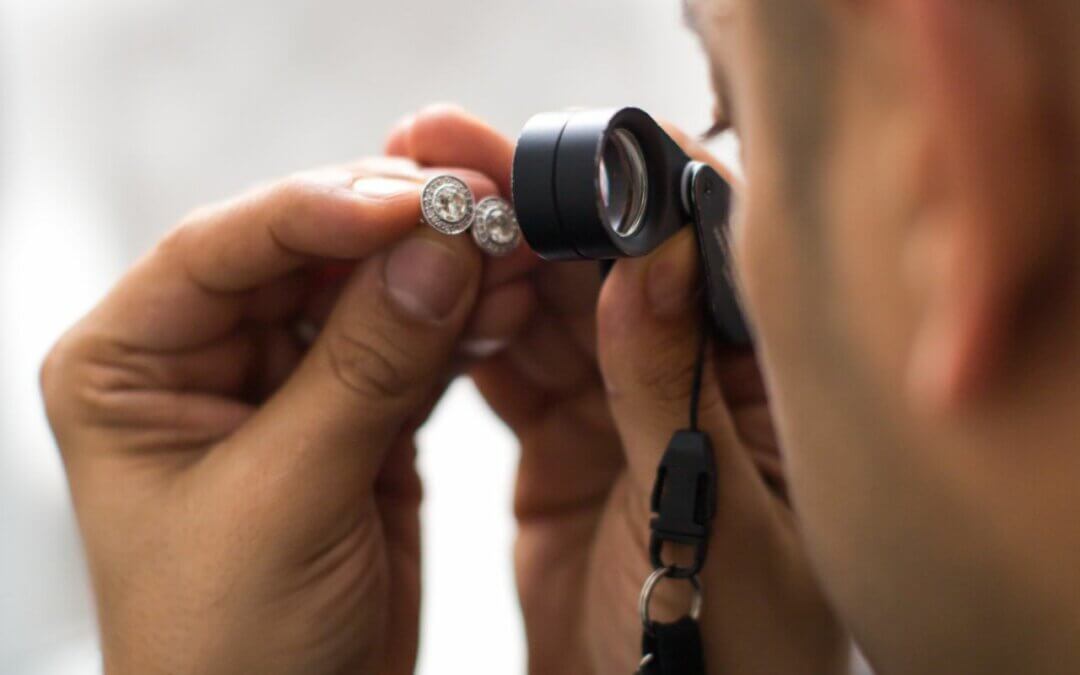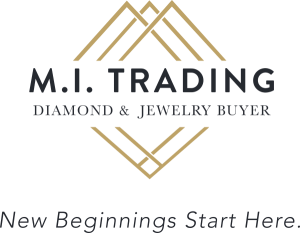If you own a diamond, whether it’s a cherished heirloom, a one-carat diamond ring from a significant milestone, or a pair of stud earrings, you’ve probably wondered about its true worth. Diamonds are known for their value, but determining the precise diamond’s value involves more than just market intuition. Understanding diamond grading systems, the 4Cs of diamond quality, and the role of certified evaluations is essential to accurately assess your diamond’s quality and value.
This guide delves into the details of diamond grading reports, the importance of certifications like those provided by the Gemological Institute of America (GIA), and how the 4Cs—Carat, Cut, Clarity, and Color—impact a diamond’s worth. Whether you’re looking to sell, insure, or simply understand the value of your diamond, this information will empower you to make informed decisions.
Why Diamond Evaluations and Appraisals Matter
A diamond appraisal is a crucial step in determining the quality and value of a diamond. It involves a professional evaluation to assess the quality and monetary worth of the stone in specific contexts, such as:
- Insurance purposes: Protect your investment by ensuring accurate coverage for your diamond, based on its grade and diamond grading report.
- Divorce settlements: Establish the diamond’s quality and resale value for legal proceedings.
- Selling your diamond: Know what your diamond is worth with an accurate appraisal to avoid undervaluation.
The Role of Grading Systems in Appraisals
Certified appraisers rely on established grading systems, such as those developed by the Gemological Institute of America (GIA), to evaluate the quality of a diamond. The GIA’s diamond grading system examines essential factors like:
- Grading scale for color: Determines how colorless the diamond appears, as indicated in grading charts.
- Diamond grade: Reflects the cut, clarity, and carat weight of the stone.
- Inclusions and blemishes: Identifies imperfections or reflections within the diamond that impact its value.
These evaluations use grading laboratories and tools to generate grading reports and a diamond certificate. This certificate provides a detailed analysis of the diamond’s quality and value, offering proof of its certified diamond status.
Why Accurate Appraisals Matter
An accurate diamond grading report ensures you have an informed understanding of what makes a diamond valuable. By utilizing trusted systems like the GIA, appraisers can provide you with a detailed understanding of your diamond’s grade and market worth. Whether for insurance, legal matters, or resale, an appraisal backed by a diamond grading system and comprehensive grading reports is essential for protecting your investment.
What Are Certified and Non-Certified Evaluations?
Certified Diamond Evaluations
A certified diamond evaluation is a professional assessment conducted by experts affiliated with trusted organizations like the Gemological Institute of America (GIA) or the American Gem Society (AGS). These evaluations use standardized methodologies and grading laboratories to provide reliable and consistent information about the value of a diamond.
Key features of certified evaluations:
- Comprehensive Reports
A GIA diamond grading report includes key metrics such as carat weight, clarity grade, and color grade. Whether you’re assessing a one carat diamond or a larger stone, certified evaluations provide detailed insights into the diamond’s attributes. - Accurate Assessments
The GIA grading scale ensures that even minor inclusions and blemishes are accounted for, offering a precise picture of the diamond value. This level of detail helps determine how much a diamond is worth in the global diamond industry. - Global Credibility
A GIA diamond certificate provides an internationally recognized benchmark for the value of the diamond and ensures consistency across markets. It allows buyers to confidently compare an individual diamond or a beautiful diamond like yours with others.
The 4Cs: The Foundation of Diamond Value
The 4Cs of diamond quality—Carat, Cut, Clarity, and Color—serve as the standard for evaluating the quality of a diamond. These factors determine the diamond’s value, beauty, and price. Whether you’re looking for a diamond or planning to sell one, understanding the 4Cs is essential.
Carat Weight
The diamond carat weight refers to how much a diamond weighs, with one metric carat equaling 200 milligrams. A 1-carat diamond, for instance, often holds more value than multiple smaller stones. Larger stones like a 1.00-carat diamond or a 1.01-carat diamond are rare and command higher prices. For those considering a diamond purchase, carat weight is one of the most noticeable factors in determining value.
Diamond Cut
The diamond cut is crucial to a diamond’s brilliance and sparkle. A well-cut diamond, featuring perfect symmetry and expertly angled facets, maximizes light interaction, enhancing the stone’s beauty. The cut directly impacts the overall appearance and price of the diamond.
Diamond Clarity
Diamond clarity refers to the presence of inclusions and blemishes. Using a clarity grade ranging from FL (flawless diamond) to I3 (included), the clarity of a diamond influences its rarity and value. A flawless diamond is exceptionally rare, significantly increasing its appeal for those seeking perfection in their diamond inventory.
Diamond Color
The diamond color measures how colorless a stone is, graded from D (colorless diamond) to Z (light yellow). A colorless white diamond is the most sought-after, fetching higher prices due to its rarity and timeless beauty. A higher color grade means better brilliance and value for buyers who choose a diamond based on aesthetics.
The Importance of Research Before Buying or Selling
Whether you want to purchase a diamond or sell one, preparation is key:
- Understand Grading Reports
Learn how to read grading reports, which detail factors such as carat weight, clarity grade, and color grade. - Work with Diamond Experts
Seek evaluations from diamond professionals and trusted grading laboratories like the Gemological Institute of America (GIA). - Assess Market Trends
Monitor the diamond market to determine the best time for a diamond purchase or resale.
By following these steps, you’ll maximize the value of your diamond, whether it’s a 1-carat diamond or a flawless diamond.
How to Evaluate Diamonds
When evaluating a diamond, focus on both physical attributes and professional certifications:
- Carat Weight: Larger stones, like a 1.01-carat diamond, are often more valuable.
- Diamond Cut: Ensure it’s a well-cut diamond with precise symmetry for maximum sparkle.
- Clarity and Color: Use grading charts to understand the clarity of a diamond and its diamond color.
For the most accurate results, always work with diamond professionals and certified grading laboratories like GIA. Whether you’re looking for a diamond to add to your diamond inventory or preparing for a sale, understanding the 4Cs of diamond quality will help you make the best decision.
FAQs about Non-certified and Certified Diamond Evaluation
What are the benefits of having a certified diamond?
The main benefit of having a certified diamond is that you can be confident in the quality and value of your diamond. A certified evaluation provides an unbiased assessment of your diamond’s quality, which can be helpful when it comes time to sell or trade-in your diamond.
What are the benefits of having a non-certified diamond?
The main benefit of having a non-certified diamond is that it may be more affordable than a certified diamond. A non-certified evaluation can still provide you with an assessment of your diamond’s quality, but it is not as comprehensive as a certified evaluation.
What is the best certification process for diamonds?
The best certification process for diamonds is the Gemological Institute of America’s (GIA) diamond grading system. The GIA is the world’s leading authority on diamonds, and its diamond grading system is the most respected and widely used in the industry.
Where can I find a reputable diamond evaluator?
The best place to find a reputable diamond evaluator is at a certified gemological laboratory, such as the GIA or AGS. You can also check the credentials of your gemologist on the website of the certifying body.
You’ll also be glad to know that M.I. Trading offers FREE certified diamond evaluations.
When you’re in the market for a diamond, you’ll likely come across both certified and non-certified options. So, what’s the difference between the two?
A certified diamond evaluation is performed by a professional gemologist using specialized diamond grading tools. This evaluation results in a detailed report that includes the 4 Cs of diamond quality: carat weight, cut, color, and clarity.
Certified diamonds are usually more expensive than non-certified diamonds because they’ve been independently evaluated and deemed to be of high quality. A non-certified diamond evaluation is simply an estimate of a diamond’s quality based on the naked eye.
While you might save some money by going with a non-certified diamond, you won’t have the same peace of mind as you would with a certified one. If you’re looking for a high-quality diamond, it’s best to opt for a certified option.
M.I. Trading is a leading diamond buyer in Austin, Texas. We offer free diamond evaluations and will pay you top dollar for your unwanted diamonds. If you’re looking to sell a diamond, contact us today!
What is the best way to clean my diamond?
The best way to clean your diamond is with warm water and mild soap. You can also use a commercial diamond cleaner, but be sure to follow the instructions carefully. Avoid using harsh chemicals or abrasives, as they can damage your diamond.
How do I know if my gemologist is certified?
You can ask your gemologist for proof of certification from a recognized certifying body, such as the GIA or AGS. You can also check the gemologist’s credentials on the website of the certifying body.
What is the difference between a diamond certificate and a diamond grading report?
A diamond certificate is issued by a third-party organization, such as the GIA or AGS, and it includes an official evaluation of the diamond’s quality. A diamond grading report is similar to a certificate, but it is not as comprehensive and does not include an official assessment.
What is the meaning of GIA and AGS?
GIA stands for Gemological Institute of America. The GIA is the world’s leading authority on diamonds, and its diamond grading system is the most respected and widely used in the industry.
AGS stands for American Gem Society. The AGS is a professional organization that certifies gemologists and issues diamond grading reports.
What can you look for to determine whether a diamond is pure?
The four Cs- color, clarity, cut, and carat weight- are the most important factors to consider when determining a diamond’s quality and value. However, you can also look for other signs of quality, such as symmetry, polish, and fluorescence.
What is the difference between a natural diamond and a synthetic diamond?
A natural diamond is a diamond that has been formed by nature over millions of years. A synthetic diamond is a man-made Diamond that has the same chemical composition and physical properties as a natural diamond.
How much does a 1-carat diamond cost?
The price of a 1-carat diamond varies depending on the diamond’s quality and other factors. However, on average, a 1-carat diamond costs between $2,000 and $12,000.
Unsure about the quality of your diamond?
M.I. Trading is the leading diamond evaluation company in the Austin area. We offer both certified and non-certified evaluations to ensure you are getting the best value for your money.
Our highly qualified gemologists will provide an unbiased, professional evaluation of your diamond so you can be sure you are making a wise decision.
When it comes to Austin jewelry buyers, you can always depend on honesty, respect, and the best cash offers for your jewelry. Whether you are selling jewels from an estate sale or looking to start a new chapter in your life, we make the process of selling your jewelry easier than ever.



Recent Comments